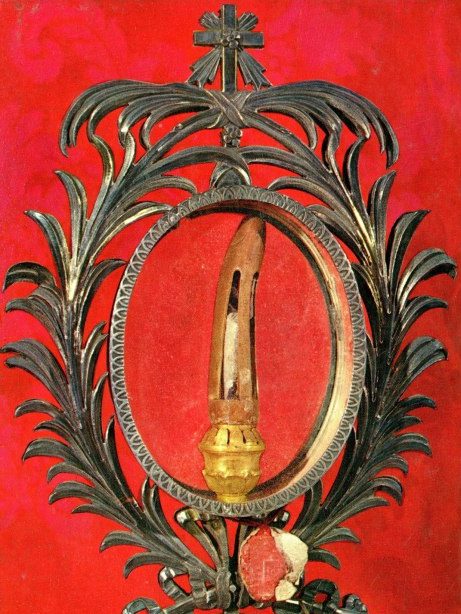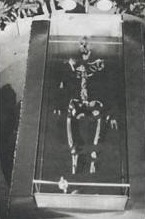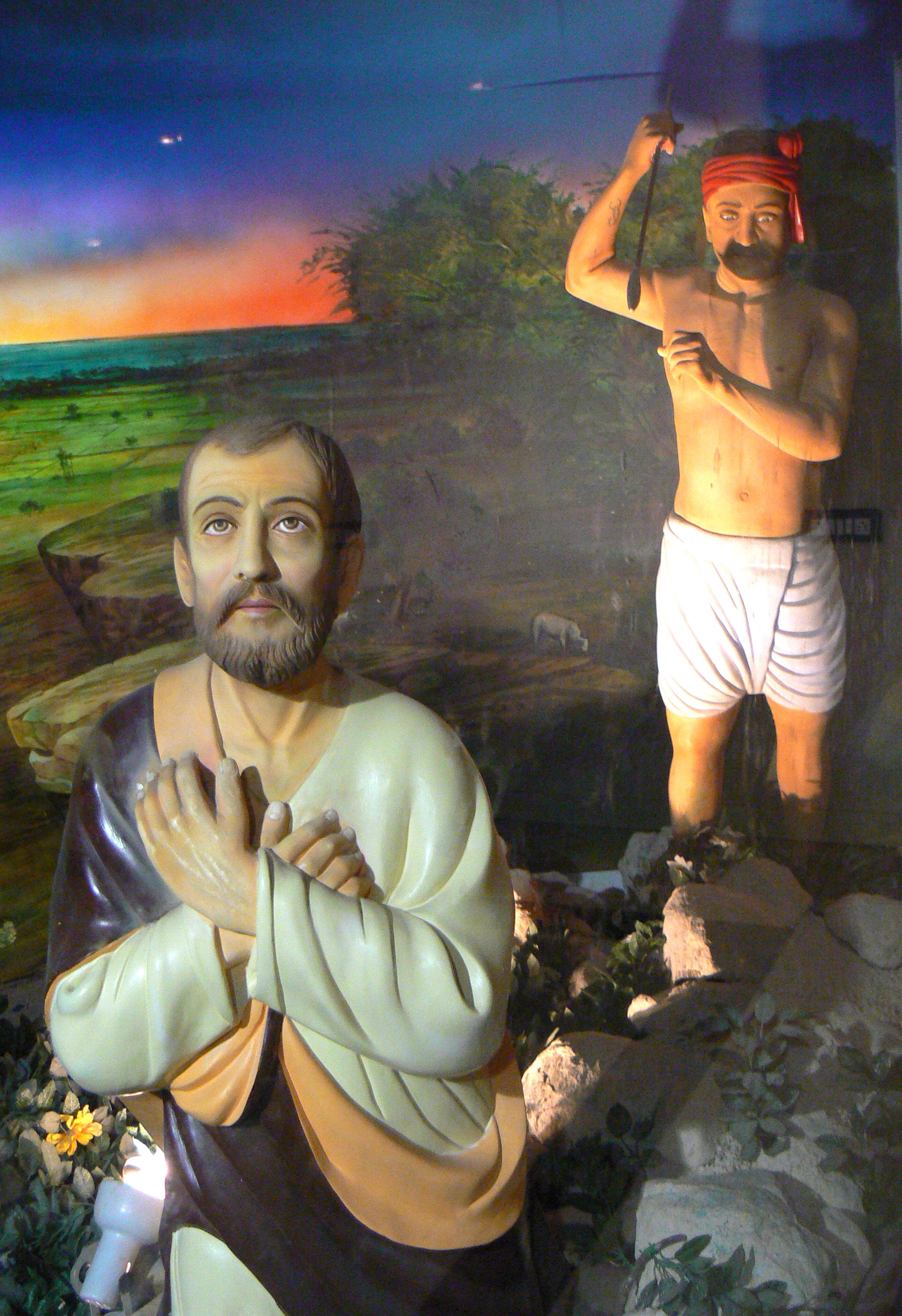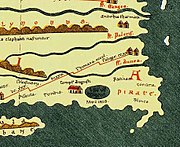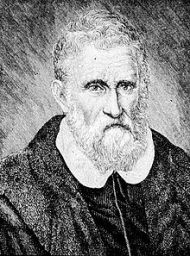

Sri Kapaleeswara Temple tank and tower (gopuram) in 1906: This is the second temple built in the 18th century by Mayil Nattu Muthiyappa Mudaliar after the Portuguese destroyed the original temple on the Mylapore seashore.

Memorial plaque placed in the Kapaleeswara Shiva Temple by Arunai Vadivel Mudaliar in 1992 with the intention of informing the public about the destruction of the original temple by the Portuguese. The plaque contains wrong information regarding the alleged visit of St. Thomas to Mylapore that should be corrected or removed.

This is the full size memorial plaque placed in the temple by Arunai Vadivel Mudaliar and others in 1992. Its reference to the alleged visit of St. Thomas to Mylapore is incorrect and should be removed.

The Acts of Thomas records that Judas Thomas and Abbanes landed at Andropolis after a short sea journey, a royal city somewhere to the east of Jerusalem. Andropolis has been identified as Sandaruck (possibly ancient Tis, modern Chabahar), one of the many Alexandrias, in ancient Gedrosia (Balochistan). The geographical term “India” has been used twice in the text of the Acts of Thomas, and it is used as a synonym for Asia.

This map indicates the traditional routes the Apostles took on their evangelising journeys. Note that Thomas’s route was to Persia-Parthia and Gandhara (now in Pakistan), not to South India.

Christian Gnostic poet Bardaisan (Syriac), Bardesanes (Latin), Ibn Daisan (Arabic) lived between 154–222 CE at Edessa (modern Urfa). He is the alleged author of the Acts of Thomas on which the St. Thomas in India fable is predicated. He had met and discussed Indian religion with Brahmin pundits and Buddhist monks who passed through Edessa en route to Alexandria and Rome, and was familiar with the Hindu and Buddhist dharmas. There is no historical evidence to show that he actually travelled to India. He uses the term “India” in the Acts of Thomas as a synonym for Asia.

Martyrdom of St. Thomas by Peter Paul Rubens (painted between 1636 and 1638). The popularity of St. Thomas as a subject for European painters came about because of the Portuguese occupation of Mylapore and the popularisation of their “discovery” of his alleged tomb there.

St. Thomas as imagined by Syrian Christians in Kerala. Neither the Cross nor Bible existed in 1st century Christianity. They would be acquired later in the 3rd and 4th century and brought to India by Syrian and Persian Christian refugees after the 4th century CE.

Pantaenus (died AD 216) was a Stoic philosopher in Alexandria who converted to Christianity and tried to reconcile Greek philosophy with Christian theology. He is believed to have visited India sometime between 180 and 190 CE where he allegedly found the Gospel of Mathew in Hebrew left behind by St. Bartholomew who is said to have reached India before him. This story is legend built on more legend. Historians today assert that Pantaenus didn’t travel further east than Arabia Felix (Southern Arabia, Oman and Yemen). And even if he did reach the Kerala coast ca. 200, it does not prove that St. Thomas (or St. Bartholomew) got there before him; it only proves that there was trade and traffic between Muziris (Kodungallur) on the Periyar River and Alexandria.

Thomas of Cana or Knai Thoma (ca. 345 CE) is the first Christian leader to have visited India according to the historical record. He was also known as Thomas the Merchant and Thomas of Jerusalem and it is very probable that Syrian Christians have identified this Thomas with their 1st century patron saint and apostle, Judas Didymus Thomas.

Bishop Joseph of Edessa (ca. 345 CE) was the companion of Thomas of Cana. There is no historical reference to him after his arrival in Malabar, but he can be said to be the real founder of the Christian Church in India.

Tabula Peutingeriana: This 4th century Roman map portion shows the ancient port of Muziris at the mouth of the Periyar River in Kerala. The port existed for 2500 years and allowed India to trade with West Asia and Europe up the 13th century when it suddenly disappeared due to a natural disaster.

Cosmas Indicopleustes (ca. 6th century): This Nestorian Christian merchant and traveller from Alexandria visited the Malabar Coast in 522 CE. He is the first person to leave an authentic record stating that there were Syrian Christians living in Malabar and Ceylon. Cosmas is the author of the book called Christian Topography.

Kodungallur Bhagawati called Sri Kurumba Amman: According to triumphalist Syrian Christian legend, St. Thomas defeated this Kali after he landed at Azhikode in 52 CE. However She is going strong even today and it is the Apostle’s very existence and sojourn in India that has come into question!

St. Thomas Church, Azhikode, Kodungallur: The church stands on the site of the church which according to the Malabar legend St. Thomas built on his arrival at Muziris. It is more probable that the first church in Malabar was built by Thomas of Cana and Bishop Joseph of Edessa, ca. 345, on land given to them by Raja Cheraman Perumal.

St. Thomas Church, Azhikode, Kodungallur: The reliquary holds part of the right arm of Apostle Thomas. It was a gift to the Christians of Kerala from the San Tommaso Basilica in Ortona, Italy, and was brought to India by Cardinal Tisserant in 1953. In the same year St. Francis Xavier was replaced by St. Thomas as the Apostle of India. Prior to 1953 St. Thomas was known in the Church and throughout West Asia as the Apostle of the East.

San Tommaso Apostolo Basilica: The authenticated complete skeleton of Apostle St. Thomas has lain in this Ortona cathedral basilica since 1258. Therefore the Portuguese could not have found his bones in Mylapore in the 1523.

An alleged skull of St. Thomas the Apostle kept in the Monastery of St. John the Theologian, Patmos, Greece. If this is really the skull of St. Thomas, then he must of had two heads as his complete authenticated skeleton is in the San Tommaso Cathedral Basilica, Ortona, Italy.

St. Thomas Miracle: By making their sandhyavandanam water offering stand in the air, St. Thomas allegedly caused some Namboodiri Brahmins to convert to Christianity. The legend is used by Syrian Christians to establish their caste identity and the superiority of Christianity over Hinduism. It ignores the fact that there was no Christianity in the 1st century—Thomas was a Jew like his twin brother Jesus—and historians maintain there were no Namboodiri Brahmins in Malabar before the 4th century CE.

Marco Polo, (1254-1324) is the first author to place the tomb of St. Thomas in the Coromandel region in an unnamed village that the Portuguese later identified with Mylapore. He wrote, “It is in this province, which is styled the Greater India, at the gulf between Ceylon and the mainland, that the body of Messer St. Thomas lies, at a certain town having no great population.” In fact Marco Polo did not visit the Tamil coast at any time. He collected his stories from Syrian Christian merchants who visited Constantinople to trade, which he recorded in his famous book Il Milione. There is very strong doubt about Marco’s extended travels to China among scholars and even during his lifetime he was called a liar by Dante Alighieri.

Marco Polo’s Route: If Marco Polo did go to China, this map shows his land route east and his return route west by sea to Hormuz. He passed through the Gulf of Mannar and did not touch the Coromandel Coast. His story that the tomb of Thomas lay in an unnamed village in the Coromandel region is pure fiction.

Marco Polo is the first writer to put the tomb of St. Thomas on the seashore in South India. Prior to his reference in Il Milione, all legends followed the Acts of Thomas for the location of the tomb on a mountain containing the sepulchres of kings in Parthia.

San Tommaso Cathedral Basilica (Basilica-Concattedrale di San Tommaso Apostolo) in Ortona contains the actual tomb of Thomas the Apostle.

San Tommaso Basilica: The real tomb of St. Thomas in Ortona, Italy. The complete skeleton of the apostle has rested in this cathedral since 1258. Therefore it is not possible for the Portuguese to have found his bones in Mylapore in the 1523.

San Thome Cathedral, Mylapore, Madras, was built in 1896. The first St. Thomas church to appear on the Mylapore beach was built in 1523 by Augustinian friars against the ancient Kapaleeswara Temple wall. The Christian tactic of encroaching on Hindu buildings and holy sites and then taking them over continues in Tamil Nadu till today.

San Thome Cathedral: This empty tomb is the second tomb the Portuguese opened in 1523. The popular belief among the fisher folk of the area is that the Archbishop of Madras-Mylapore uses the tomb as a vault to store the vast wealth the church accumulated during the Portuguese period when they were looting the Hindu temples of Mylapore.

San Thome Cathedral: This diorama in the tomb crypt has been added by San Thome authorities to stir up communal feelings among the Catholic pilgrims who visit the church. According to the Acts of Thomas, the only authority for the Apostle’s travels, Thomas was executed by a Zoroastrian king in Parthia for crimes against women. His executioners were four Persian soldiers who used spears to stab him, at his own request.

San Thome Cathedral Museum: These temple pillars in the church museum probably belong to the ancient Kapalishwar Temple that the church replaced. Why hasn’t the ASI taken possession of these important artifacts?

San Thome Cathedral Museum: Temple pillars and other Hindu temple artifacts in possession of the church. Why hasn’t the ASI taken possession of these ancient artifacts.

San thome Cathedral Museum: Unidentified bones displayed in the church museum.

Wooden pole behind San Thome Cathedral: This is said to be part of the log of wood miraculously lifted by St. Thomas in the Mylapore legend. The real miracle is that it still stands and that nobody has cut it down and carted it away, as it is an alleged true relic of the Apostle.

San Thome Cathedral: The spearhead the Portuguese planted in the tomb they opened in Mylapore in 1523. According to historian Veda Prakash it was made in Goa.

San Thome Cathedral: A piece of the Apostle’s arm bone kept in a reliquary. It was a gift to San Thome Cathedral from San Tommaso Basilica, Ortona, Italy, and was brought to India in 1953 by Cardinal Tisserant.

San Thome Bishop’s Museum: Carved temple columns and other Hindu artefacts are on display in the museum, proof that a temple once stood on the site.

San Thome Bishop’s Museum: Are these the bones of the Chola prince whose tomb the Portuguese opened up in the Kapaleeswara Temple courtyard in 1523? And why are they still in the possession of the Madras-Mylapore Archdiocese?

Pope John-Paul II & Archbishop Arulappa at San Thome Cathedral Basilica, Chennai, in 1986.

Pope John Paul II praying at the Portuguese-created tomb of St. Thomas, San Thome Cathedral Basilica, in 1986. Though the Pope visited India twice, he had nothing to say about St. Thomas’s alleged visit in 52 CE. In his homily he treated the tomb as a saint’s memorial, not a true burial place.

Archbishop Dr. R. Arulappa: He fabricated fake palm leaf documents in an attempt to create a historical record for St. Thomas in India.

Madras-Mylapore Archbishop A.M. Chinnappa: In total defiance of Pope Benedict, Chinnappa and his fellow bishops planned a mega movie on St. Thomas and his fictional Indian sojourn.

Blessed Sacrament Chapel: This Portuguese church at Little Mount, Saidapet, replaces the Murugan temple that the Portuguese took over in the 16th century.

Church of Our Lady of Light or Luz Church was built in 1516 by the Portuguese. It may be the first church the Portuguese built in Mylapore. It displaces a Vishnu temple according to local tradition.

Big Mount or St. Thomas Mount. Originally the seat of Rishi Brungi (Bhrigu), it was occupied by the Portuguese after 1523 and the Shiva temple on it demolished to make way for the Church of Our Lady of Expectation.

Our Lady of Expectation Church: The Portuguese began to settle around Big Mount in 1523 and the first Christian chapel was built on the hill in 1545. The building of the church was started in 1547 after the Shiva temple it sits on was removed.

St. Thomas Mount Church: This 8th century Persian cross is inscribed with Pahlavi script and is signed by the carver as Afras the Syrian. The inscription reads, “My lord Christ, have mercy upon Afras, son of Chaharbukht the Syrian, who cut this”.

Commemorative plaque inside the St. Thomas Mount Our Lady of Expectation Church: The inscription around the cross is not Nagari Palidu (?) but Pahlavi (Persian) and reads, “My lord Christ, have mercy upon Afras, son of Chaharbukht the Syrian, who cut this”.

This “Orpheus-Bacchus-Dionysus” crucifix is dated 3rd century BCE / CE and depicts Orpheus crucified. It is of dubious origin and may be a fake. Christians adopted the cross / crucifix as a symbol only after the 3rd century CE. Crosses were introduced into Indian Christianity by Syrian and Persian Christian immigrants between the 4th and 7th century CE.

Early Christians were practicing Jews who held the cross in abhorrence as it was both a Pagan religious symbol and a Roman instrument of torture. Up to the 3rd century Christians used a fish symbol with or without the Greek word “ICHTHUS” (fish) inscribed in it to identify themselves and each other.
St. Thomas Mount Church Icon: Portuguese icon of the Virgin & Child attributed to the Apostle St. Luke. There are a number of these fake St. Luke icons in churches around the world, the most famous one being in Santa Maria Maggiore Basilica in Rome.

1964 St. Thomas India Postage Stamp: The image is of a silver bust of Thomas in the San Tommaso Basilica, Ortona, Italy.

1973 India Postage Stamp: The image is of the 8th century stone cross carved by Afras the Syrian. It is attributed to St. Thomas and kept in the Portuguese church on St. Thomas Mount.

Emperor Julian “the Apostate” in dialogue with Christian bishops. He wanted them to pay for the temples they had destroyed and replaced with churches and they wanted him to persecute them and give them martyrs. He refused and the bishops never forgave him. He was assassinated while on campaign against the Persians by a Christian officer at the behest of Bishop Basil of Caesarea Mazaca in Cappadocia.
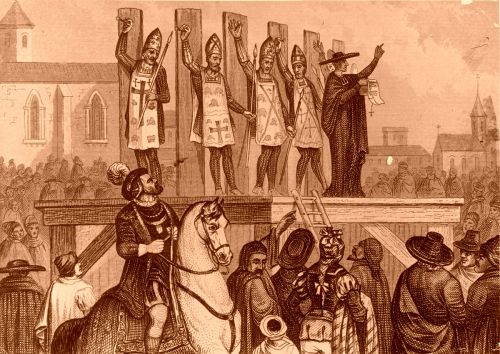
Goa Inquisition: Established in 1560 at the request of the Jesuit missionary Francis Xavier, briefly suppressed from 1774–1778, and finally abolished in 1820. Image shows Portuguese priest reading out charges against six victims—Hindus, Muslims, Jews, and back-sliding Christian converts—who have their hands nailed to stakes. They will be burned alive later in Old Goa’s public square and their property confiscated and divided between the Portuguese nobleman (on the horse) and the Church.

Historians of the 1st to 3rd Centuries: These are the Greek, Roman, Syrian, Alexandrian and Jewish historians who were contemporary or near contemporary with Jesus and Thomas but who had absolutely nothing to say about either of them.







